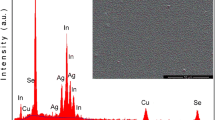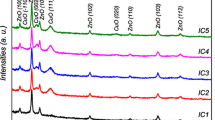Abstract
ZnInSe2/Cu0.5Ag0.5InSe2 diode structures have been fabricated by thermal evaporation of stacked layers on indium tin oxide-coated glass substrates. Temperature-dependent dark current–voltage measurements were carried out to extract the diode parameters and to determine the dominant conduction mechanisms in the forward- and reverse-bias regions. The heterostructure showed three order of magnitude rectifying behavior with a barrier height of 0.72 eV and ideality factor of 2.16 at room temperature. In the high forward-bias region, the series and shunt resistances were calculated with the help of parasitic resistance relations, yielding room-temperature values of 9.54 × 102 Ω cm2 and 1.23 × 103 Ω cm2, respectively. According to the analysis of the current flow in the forward-bias region, abnormal thermionic emission due to the variation of the ideality factor with temperature and space-charge-limited current processes were determined to be the dominant conduction mechanisms in this heterostructure. In the reverse-bias region, the tunneling mechanism was found to be effective in the leakage current flow with trap density of 106 cm−3. Spectral photocurrent measurements were carried out to investigate the spectral working range of the device structure. The main photocurrent peaks observed in the spectrum corresponded to the band-edge values of the active thin-film layers.
Similar content being viewed by others
References
J.L. Shay and J.H. Wernick, Ternary Chalcopyrite Semiconductors: Growth, Electronic Properties, and Applications (Oxford: Pergamon, 1975).
K.L. Chopra, K.L. Paulson, and V. Dutta, Prog. Photovolt. 12, 69 (2004).
M.A. Green, Y. Hishikawa, E.D. Dunlop, D.L. Levi, J. Hohl-Ebinger, and A.W.Y. Ho-Baillie, Prog. Photovolt. Res. Appl. 26, 3 (2018).
B.J. Stanbery, Crit. Rev. Sol. Stat. Mater. Sci. 27, 73 (2002).
H.H. Gullu and M. Parlak, Mater. Res. Express 3, 055901 (2016).
H.H. Gullu, O. Bayrakli, and M. Parlak, Thin Solid Films 639, 29 (2017).
H.H. Gullu and M. Parlak, J. Mater. Sci.: Mater. Electron. 29, 11258 (2018).
G. Balaji, R. Balasundaraprabhu, N. Prabavathy, M.R. Venkatraman, V. Asokan, N. Muthukumarasamy, M.D. Kannan, and K. Sivakumaran, Mater. Lett. 222, 82 (2018).
R.N. Bhattacharta and K. Ramanathan, Sol. Energy 77, 679 (2004).
S. Adachi, Earth-Abundant Materials for Solar Cells (Chichester: Wiley, 2015).
S. Darwish, A.S. Riad, and H.S. Soliman, Semicond. Sci. Technol. 11, 96 (1998).
S. Venkatachalam, D. Mandalaraj, S.K. Narayandass, S. Velumani, P. Schabes-Retchkiman, and J.A. Ascencio, Mater. Chem. Phys. 103, 305 (2007).
G.K. Rao, K.V. Bangera, and G.K. Shivakumar, Solid-State Electron. 54, 787 (2010).
R. Jeyakumar, S.T. Lakshmikumar, and A.C. Rastogi, Mater. Res. Bull. 37, 617 (2002).
P.V. Shapkin, A.S. Nasibov, Y.F. Vaksman, Y.A. Nitsuk, and Y.N. Purtov, Inorg. Mater. 42, 845 (2006).
K. Lott, S. Shinkarenko, O. Volobujeva, L. Turn, T. Nirk, A. Öpik, R. Nisumaa, U. Kallavus, M. NÖges, V. Mikli, M. Viljus, E. Gorokhova, G. Anan’eva, A. Grebennik, and Vishnjakov, Phys. Status Solidi B 244, 1623 (2007).
H.H. Gullu and M. Parlak, Mod. Phys. Lett. B 31, 1750043 (2017).
H.H. Gullu, E. Coskun, and M. Parlak, Optik 144, 603 (2017).
H.H. Gullu and M. Parlak, Surf. Rev. Lett. https://doi.org/10.1142/S0218625X19500835.
H.H. Gullu and M. Parlak, Energy Procedia 102, 110 (2016).
K. Yilmaz, M. Parlak, and C. Ercelebi, Semicond. Sci. Technol. 22, 1268 (2007).
E. Coskun, H.H. Gullu, I. Candan, O. Bayrakli, M. Parlak, and C. Ercelebi, Mater. Sci. Semicond. Process. 34, 138 (2015).
W. Mönch, Electronic Properties of Semiconductor Interfaces (New York: Springer, 2004).
A.G. Milnes and D.L. Feucht, Heterojunction and Metal-Semiconductor Junctions (New York: Academic, 1972).
B.L. Sharma and R.K. Purohit, Semiconductor Heterojunctions (Oxford/New York/Toronto/Sydney: Pergamon, 1974).
B.L. Sharma, Metal-Semiconductor Schottky Barrier Junctions and Their Applications (New York: Plenum, 1984).
H. Uslu, S. Altindal, I. Polat, H. Bayrak, and E. Bacaksiz, J. Alloys Compd. 509, 5555 (2011).
S.M. Sze and K.N. Kwok, Physics of Semiconductor Devices (USA: Wiley, 2007).
P. Singh, P.K. Rout, H. Pandey, and A. Dogra, J. Mater. Sci. 53, 4806 (2018).
M.A. Lampert, Rep. Prog. Phys. 27, 329 (1964).
R.D. Gould and M.S. Rahman, J. Phys. D Appl. Phys. 14, 79 (1981).
R.D. Gould, J. Appl. Phys. 53, 3353 (1982).
A.O. Odour and R.D. Gould, Thin Solid Films 270, 387 (1995).
M. Kaleli, M. Parlak, and C. Ercelebi, Semicond. Sci. Technol. 26, 105013 (2011).
F. Yakuphanoglu, N. Tugluoglu, and S. Karadeniz, Phys. B 392, 188 (2007).
S. Vatavu and P. Gasin, Thin Solid Films 515, 6179 (2007).
C. Ercelebi, A.W. Brinkman, T.S. Furlong, and J. Woods, J. Cryst. Growth 101, 162 (1990).
Author information
Authors and Affiliations
Corresponding author
Additional information
Publisher's Note
Springer Nature remains neutral with regard to jurisdictional claims in published maps and institutional affiliations.
Rights and permissions
About this article
Cite this article
Gullu, H.H., Parlak, M. Electrical Characterization of ZnInSe2/Cu0.5Ag0.5InSe2 Thin-Film Heterojunction. J. Electron. Mater. 48, 3096–3104 (2019). https://doi.org/10.1007/s11664-019-07070-4
Received:
Accepted:
Published:
Issue Date:
DOI: https://doi.org/10.1007/s11664-019-07070-4




